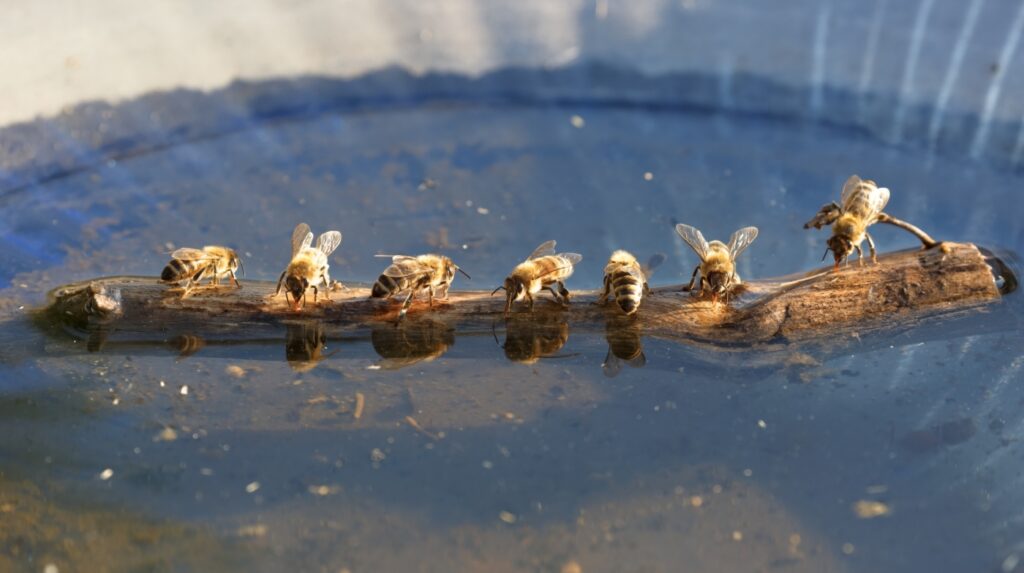
1. Bringing a birdbath or other source of water into the garden is most helpful in attracting birds, bees, and beneficial insects. The question then arises regarding mosquitoes utilizing your aqueous reservoir for breeding purposes. This problem is solved with Mosquito Dunks. These are disks that contain bacteria that, as the disk dissolves, infect and kill mosquito larvae that hatch in the water. The microbe involved is Bti (Bacillus thuringiensis israelensis), a relative of Bt (Bacillus thuringiensis), which has long been used for control of pestiferous larvae, especially those of white cabbage butterflies. Like Bt, Bti is completely non-toxic and does not harm fish, birds, or insects other than mosquitoes, blackflies, and fungus gnats. You can procure a package of six Mosquito Dunks, each of which is effective for 30 days, for around $7 through Internet vendors.
2. When planting your spring garden, consider featuring a single color. If orange is your delight, bring in orange hibiscus, firecracker plant (Cuphea ignea), orange dahlias, Judy Garland roses, and Canna var. Tropicana, which can reach six feet in height while showing off opulent orange flowers that resemble large irises and purple leaves with yellow, pink, red, and green stripes. If pink if your preference, select bee balm (Monarda didyma), Brazilian plume flower (Justicia carnea), Dianthus, pink roses, pink dahlias, and pink Alstroemeria. If you wish to stay cool with blue, choose dwarf plumbago (Ceratostigma plubaginoides), lily-of-the-nile (Agapanthus), blue hydrangeas, blue corydalis (Corydalis flexuosa var. Porcelain Blue), and blue mist (Caryopteris x clandonensis).
3. Divide clumping perennials such as Shasta daisies, penstemon, rudbeckia, daylilies, calla lilies, cannas, yarrow, bellflowers, and cymbidium orchids. You made need a knife or pruning shears to cut through denser clumps. Make sure you have a robust clump with some leaves attached before planting out the divisions in your garden, placing them in pots, or sharing with neighbors and friends. If you do gift them, make sure the recipient is instructed to plant and water the divisions immediately, as you should do as well.
4. Plant annuals now to get the most out of them before the heat compromises their initial garden growth. Petunias, million bells, marigolds, scarlet sage, cosmos, sweet alyssum, and Johnny-jump-ups are long-lasting annual favorites. It’s a rule of thumb that the most important time in the life of any garden selection is its first few days in the ground. If you get your annuals off to a good start, they might flower until the fall. This means soil will ideally be full of compost and organic and/or slow-release fertilizer. You can also do foliar fertilization through a hose-end sprayer that distributes a liquid or granular (mixed in water) fertilizer product.
Related Articles
How to prevent and treat pests in your houseplants
These LA-area design businesses create beautiful home decor items from upcycled materials
5 tips to save you money in the garden
Why gardeners are praising the toughness of this resilient fruit tree
Drip irrigation, azaleas and pineapples: 5 things to do this week in the garden
5. Now that the growing season has begun, it is recommended that anything newly planted be watered each day for the first two weeks. Before planting make sure that the planting hole is filled with water, drains, and is filled another time or two. The soil of whatever you are planting should be saturated as well. You can achieve this by placing your plant’s container in a bucket with several inches of water. Allow the water to soak up into the soil through capillary action. With large containers that don’t fit in a bucket, soak them slowly with a hose. A saturated condition is reached when, after watering with a very low volume stream of water from a hose, the container finally fills to the top with water. This watering protocol is recommended, in fact, for hose irrigation of container plants in general.
